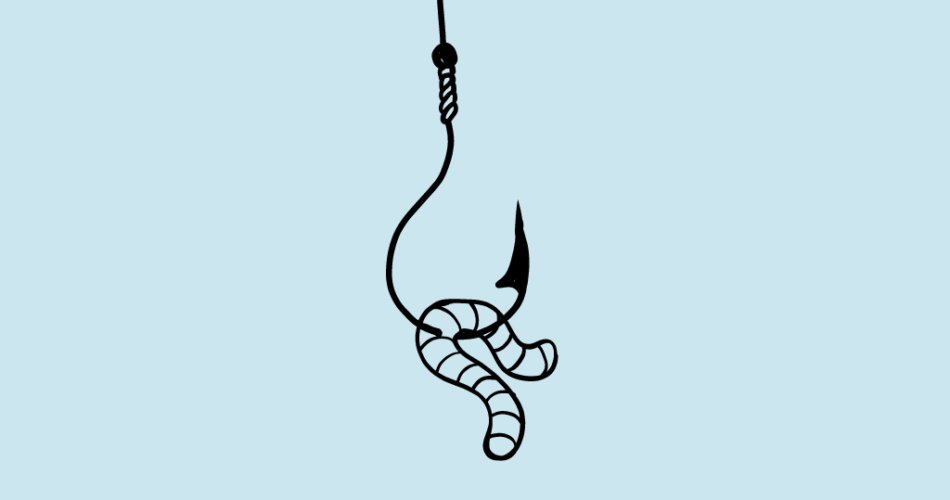Surf fishing is a great activity to spend time outdoors, meet new friends, and maybe bring some food for dinner.
However, like any other type of fishing, the amount of fish you catch when surf fishing is closely tied to the baits you use and how you use them.
That’s what this post is all about.
In this article, we’ll discover what are the best baits for surf fishing, what are the top baiting techniques on the beach, and how to effectively use each form of bait.
We will also talk about a few methods and techniques to catch bait for free and explore what are the types of bait that most surf anglers prefer.
It’s going to be a long ride, so without further ado, let’s dive in.
A quick answer
The top 5 best baits for surf fishing are shrimp, mullet, squid, worms, and sand fleas. These forms of bait help to catch a variety of species including pompano, redfish, flounder, black drum, sheepshead, bluefish, snook, striped bass, snapper, surfperch, and sharks.

The best baits for surf fishing
Shrimp
Of course. We can’t talk about the best baits for surf fishing without mentioning shrimp.
In fact, shrimp should be on the list for any type of saltwater fishing. Why? Quite simply because it’s abundant and easily accessible and also because almost all fish in the sea like it.
Shrimp can be used live, fresh, or frozen. Obviously, presenting it alive is the most rewarding option, but frozen or fresh shrimp is also very effective.
If you opt for frozen shrimp, be sure to let them thaw for a few hours before using them.
Do not put it in lukewarm water to speed up the defrosting process. Shrimp will lose a lot of liquids and odors like that and, as a result, become less attractive to the fish.
When using live shrimp, thread the hook through the tail and slide it up just under the head.
Alternatively, you can start from under the head and come out from the tail. Both directions work well.
Similarly, for cut, fresh, or frozen shrimp, thread the hook through the thickest part, typically the tail, and push until you cover most of the hook.

In all cases, make sure the hook point and barb stay visible, exposed, and ready to catch fish when they bite.
Also, ensure that the shrimp is stable and securely sitting on the hook so it doesn’t fall off or crumble after the cast.
Shrimp is the way to go for species like pompano, whiting, flounder, redfish, black drum, sheepshead, bluefish, snook, spotted seatrout, and croaker.
Squid
I don’t think any hungry fish can ignore squid when it’s accessible. Squid is the “Most Wanted” food for most sea creatures, making it one of the best baits for beach fishing.
The peculiarity of squid is that you can use it for any size of fish. For large predatory fish, you can use it whole, and for smaller species, you can cut it into small pieces that fit the mouth of the fish you are targeting.
That being said, the most common way to use squid as bait is to cut it into small strips.
Strips tend to stay more secure and stable on hooks, especially when threading them back and forth multiple times.
Both fresh and frozen squid are good options. Used fresh should give you more rewards, but frozen squid is also very appealing to the fish.
I like to buy lots of fresh squids, cut them into 2-inch long strips, and then store the strips in little bags that I can put in the freezer.
This provides me with a good supply of bait for many trips to come and saves me the headache of procuring bait whenever I decide to go fishing.
Just like shrimp, let frozen squid thaw on its own and never use water.
Another way that surf anglers use squid is by adding it on top of other baits such as crabs, clams, and baitfish. This creates great cocktails that fish cannot refuse.
Squid is ideal for striped Bass, bluefish, flounder, weakfish, sea trout, tautog (blackfish), black drum, redfish, sheepshead, kingfish, whiting, and snapper.
Crabs
Crabs are a good way to go if you want to target bottom-feeding fish like pompano, permit, redfish, blackfish, and sheepshead.
There are several species of crab. Blue crabs, sand fleas, green crabs, and fiddler crabs are the most common among surf anglers.
Ideally, you should stick to what is available and abundant in your area, as that is what the fish are most likely to hit.
Here again, live crabs should give you more bites and more catches.
The interesting thing about live crabs is that they remain active on the seabed and produce sand puffs as they crawl and bounce on the bottom. This helps catch fish’s eyes and encourages them to strike.
That being said, when targeting small-mouthed fish, feel free to cut up large crabs and only use half or a quarter of them.
The best way to hook a crab is to pierce the base of the shell (between the rear legs) and push the hook until it exits the top of the shell. Do not forget to take the claws off before you start this process.

Crabs are effective for catching redfish, black Drum, sheepshead, pompano, bluefish, permit, grouper, snook, and tarpon.
Sand fleas
Sand fleas (also called mole crabs or sand crabs) are abundant on many sandy beaches and are a pleasant meal for many fish. This makes them a typical bait for beach fishing and a reliable backup option when the other bait choices fail to produce satisfactory results.
Additionally, sand fleas are easy to collect as they can be found in large numbers in the swash area (near the high tide line), where you can see them moving and crawling across the sand.
A simple beach sieve to sift through the sand and here you are with enough bait for your whole fishing day.
For the best results, thread your sand fleas in #4 – #1 hooks and cast 10-30 yards from the shoreline. Don’t overcast because sand fleas tend to produce the best results just around the first sandbar of the surf zone.
For large sand fleas, you can use 1/0 or 2/0 hooks as long as your presentation stays secure and is less likely to spook the fish.
Worth noting that sand fleas can also be too small as bait. In such a case, try to stack 2-3 crabs along the shank of your hook before you cast.
Also, try to tie orange/brown plastic beads near the hook when using sand fleas. Their eggs are orange and turn brown after yachting. Therefore adding such colors to your presentation gives it a more natural look.
Sand fleas are particularly effective when targeting pompano, redfish, flounder, and other bottom-dwelling species.
Sardines and anchovies
Sardines are an outstanding bait for sea fishing.
For me, nothing comes closer in terms of attractiveness and appeal to a wide range of species.
The amount of oils and odors they release into the water makes them effortless to attract hungry fish and therefore trigger many bites.
Moreover, sardines are easy to find and you can buy more than you need for a reasonable price.
Besides all of that, what I like the most about sardines is that they offer many bait presentations to fit the type of fish you are chasing.
For sharks, red bulls, tarpon, and other similar fish, you can use them whole by piercing them through the eye or the tail.

For smaller species such as bluefish, striped bass, and sheepshead, you can cut the sardines in half and use the tail section or filet their flesh.
And for surfperch, flounder, and similarly sized fish, you can cut the sardines into small cubicle chunks or use their guts.
In general, sardines have a firm flesh and do not fall off hooks easily. But there are three tricks that you can consider to have a more stable offer.
- Opt for smaller sardines when buying them. Their flesh is firmer compared to larger ones
- To make sardines firmer and easier to hook, try soaking them overnight in a lot of table salt before utilizing them
- To prevent the sardines from spoiling while fishing, avoid exposing them to direct sunlight. If possible, keep them in a cooler or at least in a shady spot with some ice on them
Everything we said about sardines also applies to anchovies. The only difference is that anchovies are softer and smaller in size, which makes them more challenging to use.
Nevertheless, anchovies are also a great option for surf fishing. Like sardines, they are very oily and release lots of odors and liquids into the water, which is appetizing to many species, including striped bass, bluefish, flounder, and surfperch.
In general, smaller anchovies are more rewarding and easier to present whole. As we said, anchovies are softer than sardines and therefore can be impractical to use as cut bait.
If you still want to opt for cut anchovies, be sure to favor the tail section and use a magic thread to attach the flesh to the hook.
With sardines and anchovies, you can catch a variety of species such as striped bass, bluefish, fluke, flounder, bonito, mackerel, yellowtail, rockfish, halibut, tuna, redfish, Snook, and sharks.
Mullet
Undoubtedly, mullet is one of the best baits for surf fishing. Why? Simply because it’s easily affordable and effective in enticing a large pool of saltwater species.
Whether used live, fresh, or frozen, mullet proves its worth as a versatile bait.
Yes, presenting it alive yields the best results, but fresh and frozen mullets are equally effective in attracting a variety of fish.
Now, when opting for frozen mullet, it’s important to allow it to thaw naturally for a few hours. Avoid the temptation to accelerate the process with lukewarm water, as it can diminish the mullet’s appeal by causing significant liquid and odor loss.
For live mullet, threading the hook through the tail and sliding it up just beneath the head, or vice versa, ensures a secure presentation.
Likewise, for cut, fresh, or frozen mullet, threading the hook through the thickest part, typically the tail, covering most of the hook, proves to be a good approach.
Regardless of the presentation, maintaining the hook point and barb visible is critical. You want your hook to be ready to secure a catch whenever and wherever a fish bites.
Mullet is a good bait for many species, including pompano, whiting, flounder, redfish, black drum, sheepshead, bluefish, snook, spotted seatrout, and croaker.
Worms
Worms are a good meal for many saltwater species and one of the best baits for surf fishing.
What’s great about worms is that you can get them completely free whenever you plan to fish.
A simple dig in your garden or the intertidal zone can provide you with more worms than necessary.
There are many options here.
Nightcrawlers, bloodworms, lugworms, wax worms, etc. Anything you use has the potential to be a prolific bait. Just make sure the worms you cast are fresh, alive, and moving.
You don’t want to cast a dead worm as It doesn’t interest the fish.
The best approach for using a worm as bait involves piercing it through the mouth and then sliding it along the hook until the entire hook is concealed.

If needed, it’s fine to continue pushing the worm until it begins threading onto the line or leader.
After ensuring the hook is fully covered, carefully expose the hook’s point, making sure the barb remains visible.
Another easy way to use worms as bait consists of threading the hook back and forth several times with a worm until it gets well stuck to the hook.
Worms are very effective for catching surf perch, corbina, flounder, red drum, whiting, croaker, bluefish, pompano, striped bass, and mullet.
Which baits do surf fishermen prefer?
In our surf fishing survey, we asked 358 fishermen about their most rewarding bait when surf fishing, and shrimp emerged as the most preferred option, receiving 27.37% of the responses.
Following closely behind was mullet, with 15.08% of votes, while squid garnered 46 votes (12.85%), highlighting its popularity as a productive bait option.
Worms and sand fleas both received about 9% of the responses, demonstrating their comparable success rates.
Sardine accounted for 6.70% of the preferences, while clams and menhaden received 4.75% and 3.07% of votes, respectively.
The “Other bait” category encompassed a range of bait options, accumulating 10% of the responses, emphasizing the diversity of bait preferences among surf fishermen.
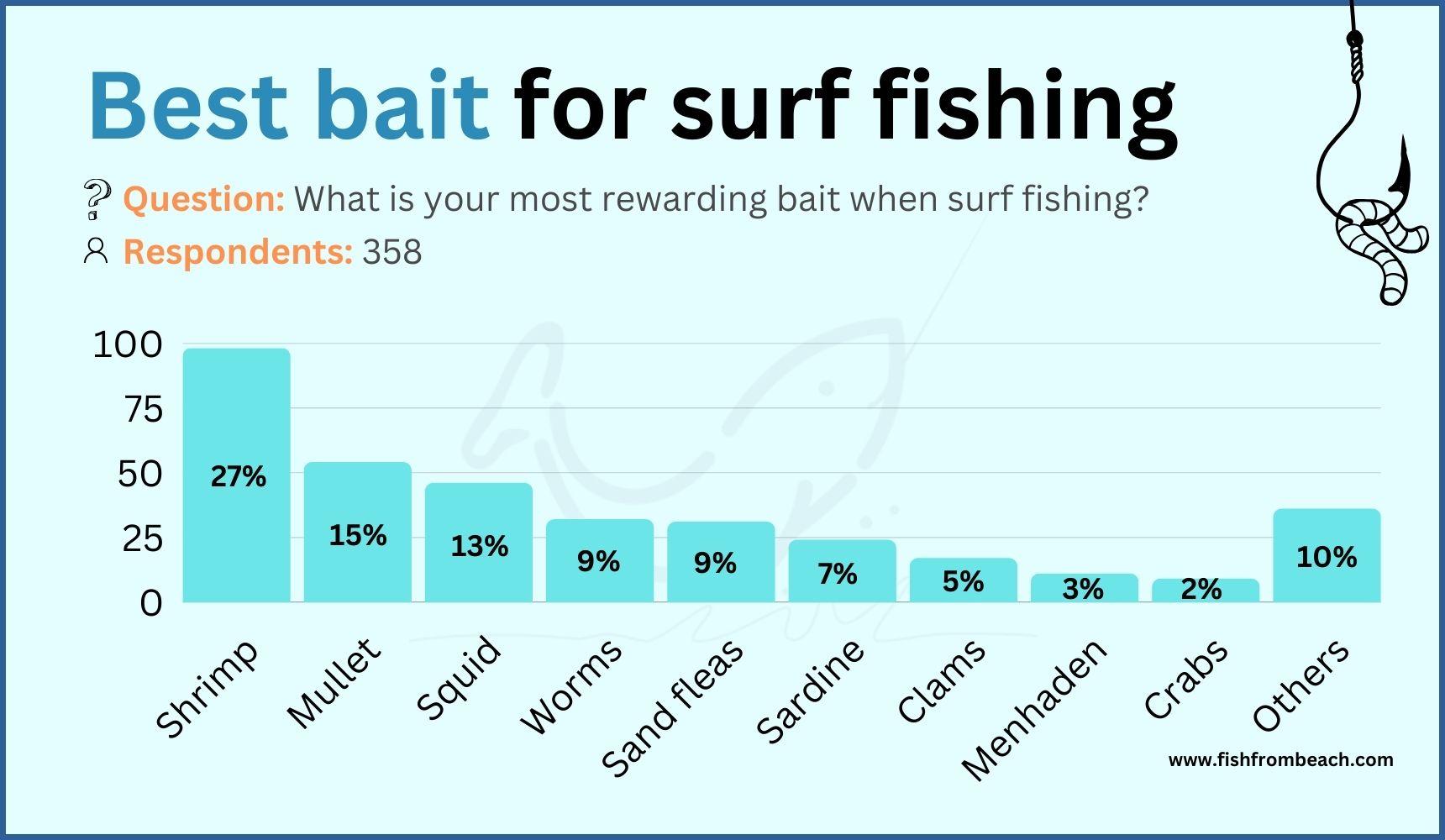
How to choose the best bait for surf fishing?
Now that we’ve explored the best bait options for beach fishing and what fellow anglers prefer, let’s answer the important question: How can I make sure I’ve made the right choice?
Well, worth noting here that choosing a bait for surf fishing is rarely a difficult task.
When fish are active, they tend to take whatever food you give them.
Conversely, when the bite is low, your bait selection is unlikely to change much in your scores.
That being said, there are some good practices to follow in order to maximize the appeal of your offer and entice more fish to strike your bait.
Your bait should be famous
The most important thing to consider is that your bait should be available and abundant where you fish.
Fish are more likely to eat the food they are familiar with. Casting something strange will make them hesitate and think more before making any move.
For instance, if you plan to use baitfish, find out about the schools of baitfish that run down the coasts you want to fish. This is the bait you should attach to your hooks.
Similarly, if you want to use crustaceans, observe the shellfish beds available in your area and then use the species you find as bait.
Exploring the beach at low tide helps a lot here. Any form of shellfish you find in the intertidal zone can be an excellent bait for surf fishing.
Asking local anglers is also a great thing to do, especially if it’s your first time fishing in an area.
Local tackle providers are also a generous source of information. So don’t be shy to ask.
Favor live bait
The next thing to remember is that nothing beats live bait when surf fishing.
Live bait stays active after casts and keeps moving in the water body, simulating live prey and therefore drawing the attention of predators.
Dead bait, on the other hand, produces much less movement in the water, which doesn’t help in attracting fish.
Additionally, live bait is more durable than dead bait, as it can be used for a long time, without the need to change it after every cast.
Dead bait is most effective when used fresh and smelly, which requires frequent renewal and speedy casting and retrieval.
On top of that, and as we said, live bait can be more cost-effective than dead bait, as it can often be caught and collected for free from the beach.
Fresh over frozen
When opting for dead bait, lean towards fresh over frozen.
While frozen bait may be more convenient to transport and store, fresh bait is always the better choice in terms of attractiveness and appeal to the fish.
Fresh bait has a stronger scent and therefore helps in attracting fish from a greater distance and producing more bites and catches.
Frozen bait, on the other hand, loses its freshness and scent as it taws, which makes it less appetizing to the fish.
Additionally, fresh bait has a firmer texture than frozen bait, which makes it less likely to fall off hooks after casts.
Also, fresh bait is a more versatile option as it can be cut, shaped, or prepared in different ways to match the conditions or species you’re fishing for.
Finally, remember that the best bait for surf fishing changes with the season and weather conditions. What works like a charm in the summer won’t necessarily perform the same way in the winter.
So be sure to do your homework every now and then.
We’ve dived deeper into such tips in our ebook “101 Tips for Surf Fishing.” The information and insights provided within are certain to answer all your questions and spare you a lot of research and experimentation. So be sure to give it a look.
Best bait per fish species
Now, let’s delve into more detail and discover the best bait for common surf fishing catches:
Pompano
- Shrimp: Whole, fresh, or live
- Sand fleas: Whole, live
- Mullet: Cut, fresh
Flounder and fluke
- Shrimp: Whole or cut, fresh or live
- Squid: Strips, fresh or frozen
- Sardines: Cut, fresh
- Mullet: Cut, fresh
- Worms: Whole or cut, live or dead, fresh
- Crabs: Whole or cut, live or dead
Redfish
- Shrimp: Whole or cut, live or fresh
- Squid: Strips or whole, fresh or frozen
- Crabs: Whole or cut, live or dead
- Sardines: Cut, fresh
- Mullet: Whole or cut, live or fresh
- Sand fleas: Whole, live
Black Drum
- Shrimp: Whole or cut, live or fresh
- Squid: Strips, fresh or frozen
- Crabs: Whole or cut, live or dead
- Sardines: Cut, fresh
- Mullet: Whole or cut, live or fresh
- Sand fleas: Whole, live
Sheepshead
- Shrimp: Whole or cut, live or fresh
- Squid: Strips, fresh or frozen
- Crabs: Whole or cut, live or dead
- Sardines: Cut, fresh
- Mullet: Cut, fresh
- Sand fleas: Whole, live
Bluefish:
- Shrimp: Whole or cut, fresh or live
- Squid: Strips or whole, fresh or frozen
- Sardines: Whole or cut, fresh or frozen
- Worms: Whole, live
Snook
- Shrimp: Whole or cut, fresh or live
- Squid: Strips or whole, fresh or frozen
- Crabs: Whole or cut, live or dead
- Sardines: Whole or cut, fresh or frozen
- Mullet: Whole or cut, fresh or live
- Sand fleas: Whole, live
Spotted Seatrout
- Shrimp: Whole or cut, fresh or live
- Squid: Strips, fresh or frozen
- Mullet: Whole or cut, fresh or live
Striped Bass
- Squid: Whole or strips, fresh or frozen
- Shrimp: Whole or cut, fresh or live
- Sardines: Whole or cut, fresh or frozen
- Worms: Whole, live
- Mullet: Whole or cut, fresh or live
Snapper
- Squid: Whole or strips, fresh or frozen
- Shrimp: Whole or cut, fresh or live
- Sardines: Whole or cut, fresh or frozen
- Mullet: Whole or cut, fresh or live
Mackerel
- Sardines: Whole or cut, fresh or frozen
- Mullet: Whole or cut, fresh or live
- Anchovies: Whole or cut, fresh, frozen, or live
Sharks
- Mullet: whole or cut, fresh or live
- Sardines: Whole or cut, fresh or frozen
- Bonito: Cut, fresh or frozen
- Bluefish: Cut, fresh or frozen
Surf Perch
- Worms: Whole, live
- Squid: Strips, fresh or frozen
- Sardines: Cut, fresh or frozen
- Crabs: Whole or cut, live or dead
- Shrimp: Whole or cut, fresh or live
- Sand fleas: Whole, live
Mullet
- Worms: Whole, live
- Sardines: Cut, fresh or frozen
- Sand fleas: Whole, live
- Shrimp: Whole or cut, fresh or live
- Squid: Strips, fresh or frozen
How to catch bait on the field?
When preparing for a beach fishing trip, getting the bait you need can be a time-consuming and costly task. This is why you should learn a few methods to collect live bait while on the field.
A cast net is by far the most efficient way to catch live baitfish in the surf, as it makes it easy to capture minnows, mullets, or any other small fish that may be found in your area.
All you need to do is to wait until a school of baitfish swims by and then throw the net. Or, if you want to be proactive about it, you can chum the first few yards (Learn how here) of the surf and wait for fish to gather around the chum elements.
Another effective method I use to attract baitfish is to fill an onion bag with bloody fish scraps, heads, and carcasses, and throw it a couple of yards off the shoreline.

As soon as a fair amount of baitfish start orbiting around the bag, I throw the net and pull it slowly to shore.
Generally speaking, I only need 3 to 4 casts to harvest enough live bait for the day.
One thing to remember here is that the holes in your net should be smaller than 1/4 inch so that fish can’t sneak their way out. Also, opt for a net that is quite wide when fully open, as this allows you to cover a larger area and increases your chances of success.
Personally, the net I use is the 7ft, 1/4 mesh cast net from Betts.
A sand flea rake is another great tool to gather sufficient amounts of bait easily and for free.
With the help of a sand flea rake, you can sift through the sand to find and collect sand crabs, worms, sandfleas, and other small creatures that you can use as bait.
It’s therefore a great tool if you want to quickly and efficiently gather bait without having to dig through the sand with your hands or a shovel.
How to make a baitfish trap?
There are a lot of ready-to-use fish traps that you can buy online, but here, I want to share with you how I make my own traps easily using very little (and basic) equipment.
All you need is hand gloves, a wire cutter, 2 fence rolls (hardware clothes), and a bunch of zip ties.
The size of the two rolls depends on your objectives and how many bait fish you want to catch. Larger rolls will allow you to make bigger traps with more fish capacity.
For a baitfish trap, the rolls need to be something around 5×4 ft or 5×3 ft.
These are the sizes I most use and they always work great. If you can’t find such sizes, be creative about it. Look for a fence roll that is 10×4 ft or 10×3 ft and cut it into 2 parts. Problem solved 😉
Now with the two rolls in hand, you also need to grab one and cut in half to obtain 3 clothes :
- 1 large cloth of a 5×4 ft size (or 5×3 ft)
- 2 smaller clothes of a 5×2 ft size (or 5×1.5 ft)
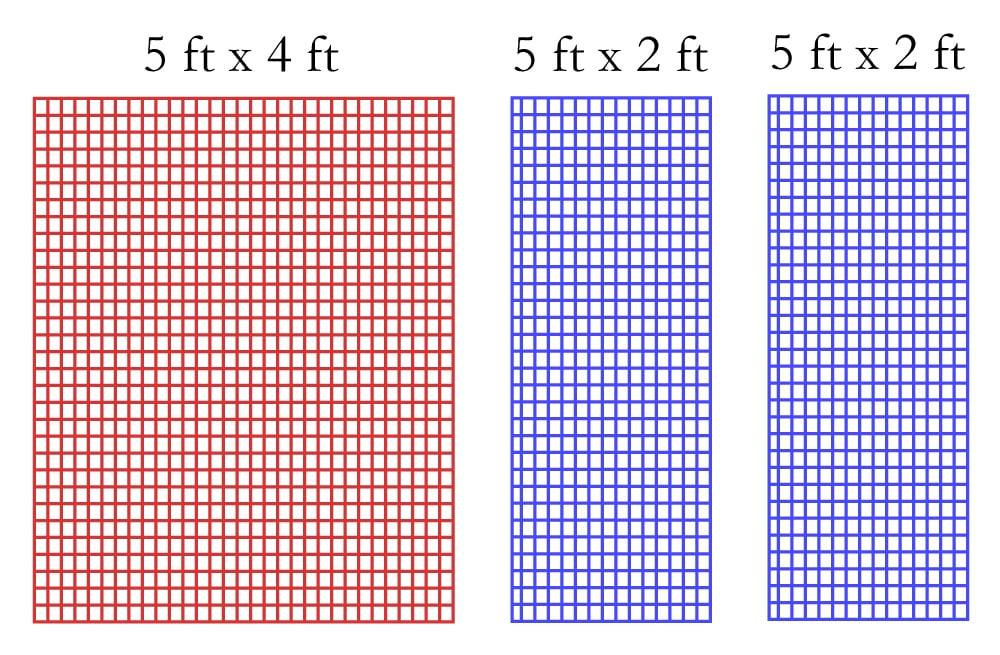
Another important thing to consider when choosing the hardware clothes is the mesh.
The mesh is the size of the holes in the fence. You want those to be small and tight so tiny fish can’t sneak through the trap walls.
For minnow-sized fish, meshes of 1/8 – 1/4 inch tend to be the most effective ones.
Now let’s start crafting our trap.
Step 1
Wrap the larger fence to form a cylinder shape and use zip ties to join the 2 edges of the cloth. Don’t forget to cut the cables of the zip ties when you’re done.
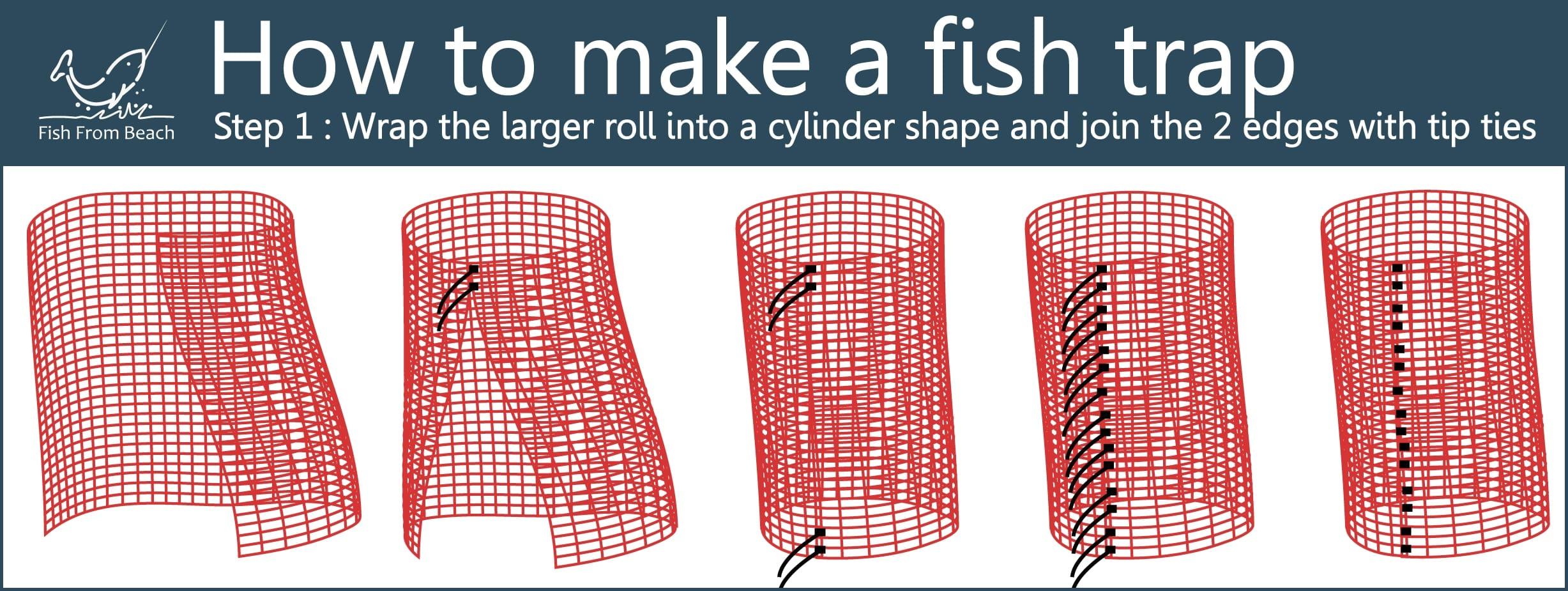
Step 2
Now use a wire cutter to create a square hole in the lower part of the cylinder. We will use this hole later to fill the trap with chum elements, and also to get out the baitfish we catch.
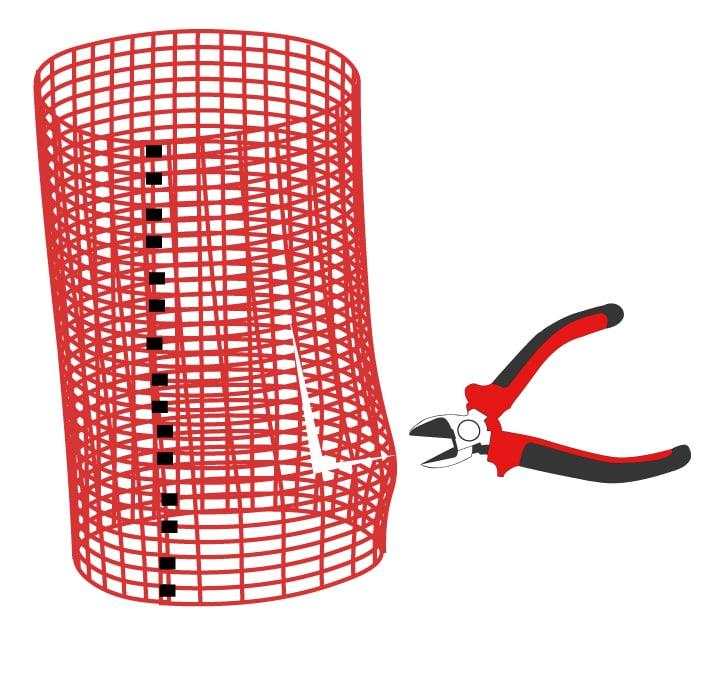
Step 3
Pick one of the smaller fences and wrap it to form a cone shape. The size of the base should depend on the fish you want to catch. In other words, you want the hole to be as tight as it needs to let the fish in. For baitfish, the base needs to be 2-3 inches max.
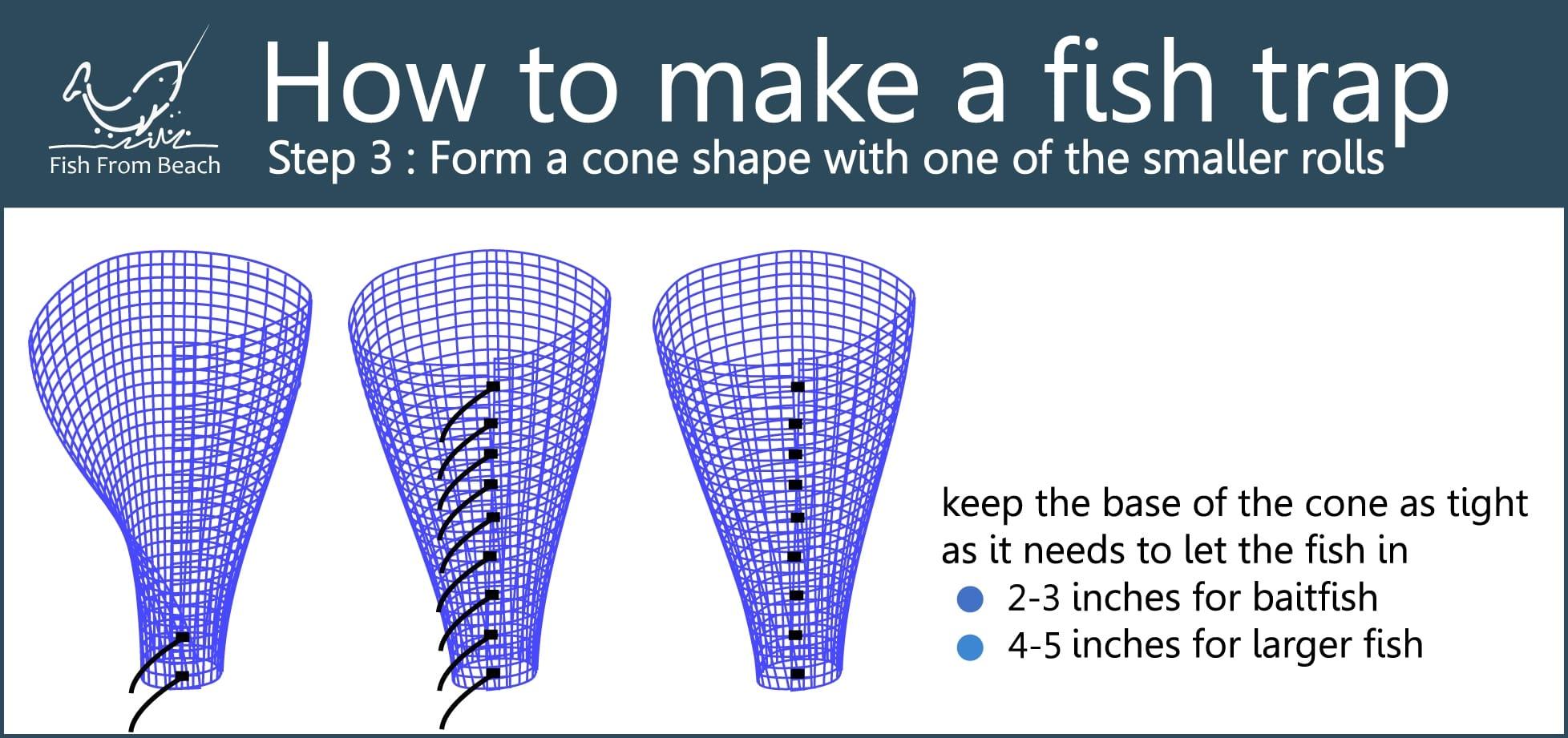
When you tighten the base, don’t worry too much if the cone takes a weird shape at the top. We will correct that in the next step.
Step 4
Insert the cone-shaped fence into the cylinder one. Make sure the top of the two are adjacent and that fish can’t swim in between.
Now with the wire cutter, cut off the excess at the top and use zip ties to join the top of the two fences.
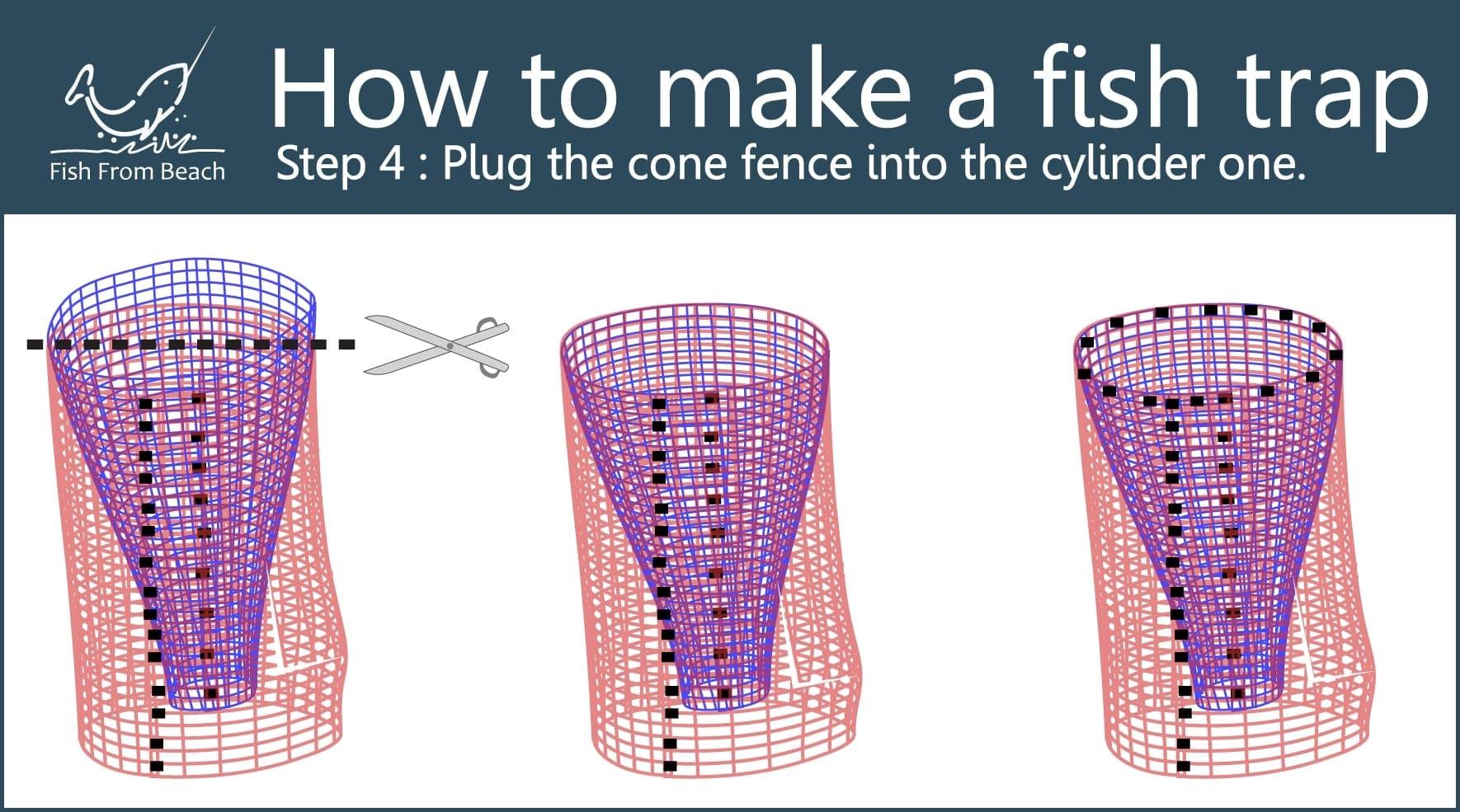
Remember to leave at least 5 to 6 inches (or more) between the base of the clone and the base of the cylinder. This will make the trap less spooky and the fish will be more comfortable to get in.
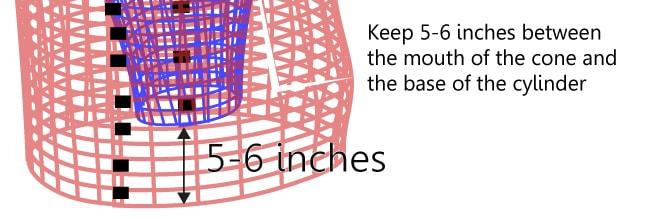
Step 5
Now is the time to use the last roll to cover our trap. To do this, I simply spread and fold the cloth over the cylinder-shaped fence. This can be quite difficult to do, so make sure to wear gloves to protect your hands.
Also, make sure you are covering the right side. You want to cover the side where you have the base (the smaller side) of the cone.
After you finish, use the wire cutter and some zip ties to fixate the cover and to make the trap look prettier 😀
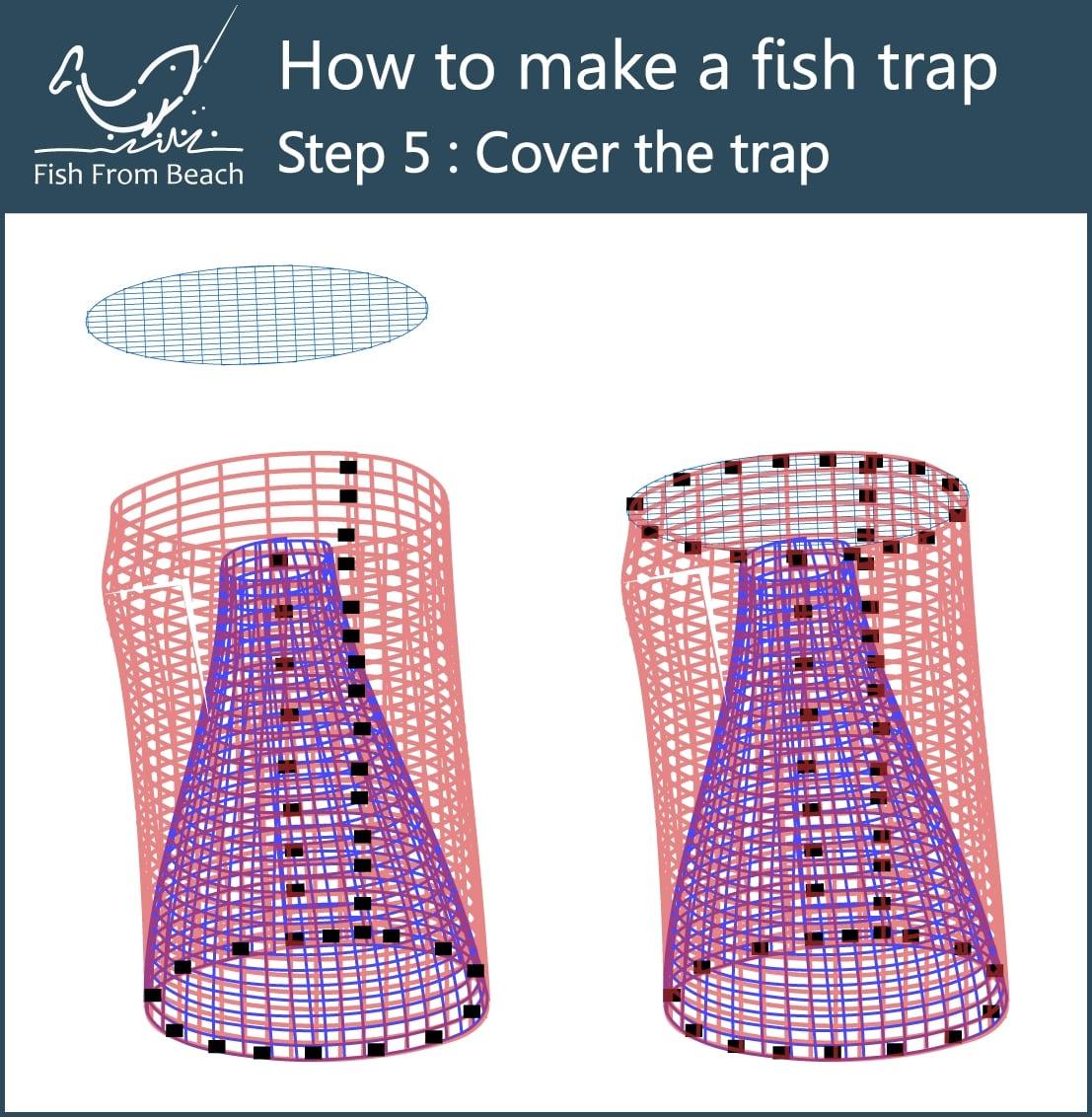
That’s it. You now have an excellent fish trap that you can use to catch plenty of bait fish in the surf.
As said earlier, fill the trap with some fish scraps and leave it in the first trough to do the job.
Fish will smell the chum and move closer to investigate the trap. They will keep orbiting around until they figure out how to access food safely. Once inside, it will be more difficult for them to get out. Some will manage to do that, but most fish will remain stuck in there until you retrieve the trap.

Note (*): If you make a purchase through links from this website, we may get a small share of the sale from Amazon or other similar affiliate programs.
Surf Fishing Survey
Help us provide you with better content by answering simple questions about your surf fishing experience and knowledge.
We will put the collected responses together and turn them into valuable information that will help you catch more fish from shore 😉
Note: No personal information will be collected with your answer.

